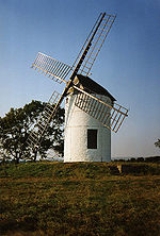
Ashton Windmill
Encyclopedia
Ashton windmill is a Tower mill
in Chapel Allerton
, Somerset
, England
. Its tower is over 7.5 metres (24.6 ft) high with stone walls that are 60 cm (2 ft) thick. The sails are 13 m (42.7 ft) across and used to be covered with canvas. The last millstones were 1.2 m (3.9 ft) across and the millstones used to grind wheat for flour and beans for cattle food.
The first mill on the site was medieval, but the present structure probably dates from the 18th century. It was modernised in 1900 with machinery brought from the demolished Moorlinch
mill, and iron hoops around the building being added. It was restored in 1967. The mill has been designated by English Heritage
as a grade II* listed building.
It is now preserved, having been given to Bristol City Museum
in 1966 and is owned by Sedgemoor District Council
, and maintained by volunteers.
In 2008 the council applied for listed building planning consent to undertake major restoration work on the windmill, including replacement of the stone steps, installation of hand rails, guard rails and safety bars, alterations to the window shutters and replacement of the sail frames with wood laminate.
In 2010 Sedgemoor Council decided it could no longer afford to maintain the windmill and has appealed for an independent group of trustees to take on the responsibility for the building.
Tower mill
A tower mill is a type of windmill which consists of a brick or stone tower, on top of which sits a roof or cap which can be turned to bring the sails into the wind....
in Chapel Allerton
Chapel Allerton, Somerset
Chapel Allerton is a village and civil parish, south of Cheddar in the English county of Somerset. The parish includes the hamlets of Ashton and Stone Allerton.-History:...
, Somerset
Somerset
The ceremonial and non-metropolitan county of Somerset in South West England borders Bristol and Gloucestershire to the north, Wiltshire to the east, Dorset to the south-east, and Devon to the south-west. It is partly bounded to the north and west by the Bristol Channel and the estuary of the...
, England
England
England is a country that is part of the United Kingdom. It shares land borders with Scotland to the north and Wales to the west; the Irish Sea is to the north west, the Celtic Sea to the south west, with the North Sea to the east and the English Channel to the south separating it from continental...
. Its tower is over 7.5 metres (24.6 ft) high with stone walls that are 60 cm (2 ft) thick. The sails are 13 m (42.7 ft) across and used to be covered with canvas. The last millstones were 1.2 m (3.9 ft) across and the millstones used to grind wheat for flour and beans for cattle food.
The first mill on the site was medieval, but the present structure probably dates from the 18th century. It was modernised in 1900 with machinery brought from the demolished Moorlinch
Moorlinch
Moorlinch is a village and civil parish where the Polden Hills meet the Somerset Levels in the Sedgemoor district of Somerset, England.-History:...
mill, and iron hoops around the building being added. It was restored in 1967. The mill has been designated by English Heritage
English Heritage
English Heritage . is an executive non-departmental public body of the British Government sponsored by the Department for Culture, Media and Sport...
as a grade II* listed building.
It is now preserved, having been given to Bristol City Museum
Bristol City Museum and Art Gallery
The Bristol City Museum and Art Gallery is a large museum and art gallery in Bristol, England. It is run by the city council with no entrance fee. It holds designated museum status, granted by the national government to protect outstanding museums...
in 1966 and is owned by Sedgemoor District Council
Sedgemoor
Sedgemoor is a low lying area of land in Somerset, England. It lies close to sea level south of the Polden Hills, historically largely marsh . The eastern part is known as King's Sedgemoor, and the western part West Sedgemoor. Sedgemoor is part of the area now known as the Somerset Levels...
, and maintained by volunteers.
In 2008 the council applied for listed building planning consent to undertake major restoration work on the windmill, including replacement of the stone steps, installation of hand rails, guard rails and safety bars, alterations to the window shutters and replacement of the sail frames with wood laminate.
In 2010 Sedgemoor Council decided it could no longer afford to maintain the windmill and has appealed for an independent group of trustees to take on the responsibility for the building.
External links
- Ashton Windmill at Sedgemoor District Council
- Ashton Windmill feature, which won CBACouncil for British ArchaeologyEstablished in 1944, the is an educational charity working throughout the UK to involve people in archaeology and to promote the appreciation and care of the historic environment for the benefit of present and future generations...
Young Archaeologist of the Year Award in 2006 for its author.

